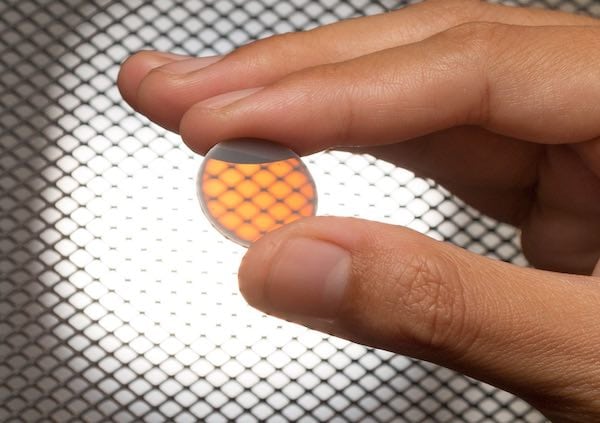
[Image above] A version of the ceramic skull implant developed by a UC Riverside-led team of researchers. Credit: David Baillot, UCSD Jacobs School of Engineering
Your brain is an island—this incredibly complex organ, which controls, regulates, initiates, or mediates nearly everything you do, is protected and yet largely isolated in your cranium.
Encased in a relatively thick layer of bone that can withstand an incredible amount of force—more force than even a man named the Mountain can generate—the brain is designed to stay safe, secure, and out of harm’s way within your skull.
But that safety comes with a caveat: medically reaching the brain for diagnostics or treatment is really quite tricky.
For instance, recent research has shown significant promise of ultrasound treatment to alleviate the symptoms of various neurological disorders, including Alzheimer’s disease, brain cancer, Parkinson’s disease, depression, multiple sclerosis, and stroke, in addition to many non-neurological diseases as well.
While there is still more to learn about how noninvasive ultrasound therapy thermally and nonthermally affects cells, its therapeutic benefits may be partially attributed to its ability to increase molecular uptake in cells, enhance gene therapy, dissolve clots, and open the blood-brain barrier.
When it comes to delivering ultrasound therapy, however, that same skull that affords our brain with so much protection also happens to inhibit ultrasound waves from reaching the complex organ—the cranium absorbs and reflects most ultrasonic waves.
So a group of researchers from the University of California, Riverside, in collaboration with the Centro de Investigación y de Estudios Avanzados (CINVESTAV) del Instituto Politécnico Nacional (IPN), in México City, has a clear idea for a solution—a transparent ceramic window implanted into the skull that would allow continued, noninvasive ultrasonic treatment of the brain.
The team recently tested a candidate ceramic—low-porosity polycrystalline 8 mol% yttria-stabilized zirconia (8YSZ)—and showed that the material allows ultrasound waves to pass through with little of the interference that bone exhibits.
The scientists tested 8YSZ with varying levels of porosity by measuring the material’s acoustic properties and evaluating wave propagation through them using finite element models.
Their results show that ultrasound attenuation is linearly dependent on ceramics’ porosity, the authors report in the abstract of a recent paper describing the work. “With the full dense samples, we obtained 80.8% of ultrasound transmission through an 8YSZ implant of 3.6 mm, in contrast to almost 10% of reported ultrasound transmission through cranial bone at the same thickness.”
8YSZ’s biocompatibility and toughness make it an ideal implant material, which is reinforced by the fact that the material is already used in dental implant and hip replacement applications.
The idea driving the investigation is that such a material could eventually be used as a small window directly incorporated into patients’ skulls. After the initial implantation procedure, the window would allow delivery of recurring, noninvasive ultrasound treatments directly to the brain.
According to Javier Garay, professor of mechanical engineering at UC San Diego and a senior author of the new paper, such an implant would be permanent or semi-permanent. And although the patient’s skin would likely grow over the ceramic implant, it might not obstruct the view. “It might be possible to use optical clearing agents to temporarily make skin more transparent and use implant that way,” Garay adds in an email.
The key to the material’s success is that the scientists densified 8YSZ via current-assisted pressure-activated densification to produce a material with low porosity, which allows ultrasound waves to pass through relatively unhindered.
“It is important to appreciate that the zirconia we developed works well for this application because we engineered it to have low porosity. Porosity, a common defect in ceramics produced by traditional methods, significantly deteriorates ultrasound transmission as we show in this paper,” Garay says in a UCR Today article.
The new work is part of the larger Window to the Brain project, which previously demonstrated that YSZ materials are viable candidates to develop implantable windows for laser-based therapies. According to the latest release, those materials are now in preclinical trials.
The team is now developing 8YSZ because it is an optically transparent material, which would allow the possibility for future brain implanted windows to deliver combination treatments that incorporate both ultrasonic and laser-based therapies.
According to Garay, the team is now assessing the biocompatibility of 8YSZ materials. “We expect them to perform even better then what is currently used since they are more dense (transparent) and have finer grain sizes.”
Other materials could be suitable for implantable windows, as well, including other stabilized zirconias and alumina, Garay indicates. “We may explore other compositions as well.”
The paper, published in Advanced Healthcare Materials, is “Novel cranial implants of yttria-stabilized zirconia as acoustic windows for ultrasonic brain therapy” (DOI: 10.1002/adhm.201700214).
Author
April Gocha
CTT Categories
- Biomaterials & Medical
- Material Innovations
- Optics


